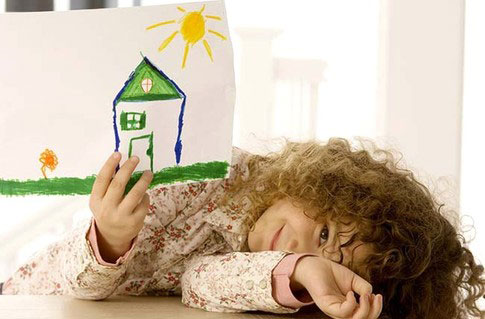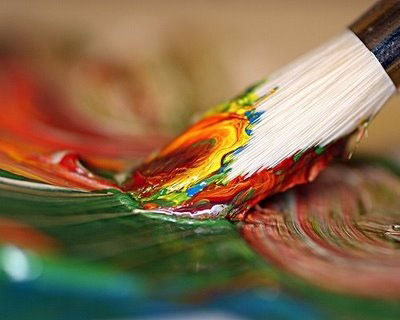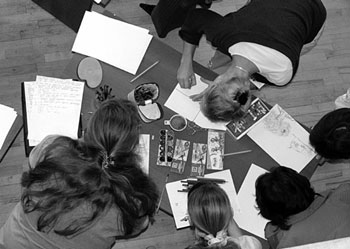Calligraphotherapy
The term “calligraphotherapy” is based on the words: “calligraphy” (from Greek Κάλλος — beauty, γράφω — write) and “therapy” (from Greek Θεραπεία — care, treatment). Calligraphotherapy or calligraphic art therapy is a form of art therapy, based on the use of calligraphic genres and techniques for psychotherapeutic purposes.
 Calligraphy as a kind of therapeutic practice
Calligraphy as a kind of therapeutic practiceBeautiful handwriting has been a source of positive aesthetic emotions at all times: scribes and calligraphers have always occupied a special place in the social hierarchy. At present when handwriting is almost completely replaced by a keyboard, the people, perhaps for the first time, have clearly emphasized the non-trivial potential of writing. Writing is no longer taken seriously from a pragmatic point of view (as a means for transmitting and storing information), but from an aesthetic point of view writing could easily compete with other visual tools.
Today, calligraphy in Russia is experiencing the “second birth” (well, it’s far from "second" actually). For more than three years in Moscow, we have been witnessing a successful development of the “International Exhibition of Calligraphy” project, different clubs have appeared (for example, “The School of Calligraphy” in Moscow and Perm). Finally, in 2008 the Contemporary Museum of Calligraphy was opened in Sokolniki.
Now it is high time to pay attention to the therapeutic resources of handwriting. It is not just about the therapy of diaries and notebooks, correspondence with the home physician or other forms of written verbalization, but — above all — the use of external aesthetic potential of lettering. Art-therapeutic approach to writing includes not only and not just work with the content of the text, but — with its form.
Calligraphotherapy is not the discovery of our times; it is an attempt to update, and sometimes to revive calligraphic genres and techniques to reveal their psychotherapeutic use. In Oriental cultures (such as Chinese, Japanese, Arabic) calligraphy will never sit tight and it still does occupy a worthy place, including that of psychological self-regulation. Western European and Russian calligraphic traditions also can be successfully employed in the psychotherapeutic process.
 A genre of art therapy
A genre of art therapyWhat kind of calligraphic genres can be used as art therapy techniques?
The first genre is Initial (from Latin Initialis — “primary”). In western calligraphy it is a specially decorated first letter of a word, sentence, chapter or other parts of the book; in the Slavonic calligraphy there is another name — the Drop capital. On this basis one can create his own initial alphabets, bearing individual significance. These illuminated words or phrases are the material expression of the aesthetic (artistic objectification) of the author’s experiences and values.
The second genre is Monogram (from Greek Μόνος — one, γράμμα — line, letter). In manuscript tradition it is a sign, composed of linked or intertwined letters. For example, the initial letters of the name and last name. In psychotherapy, it may be a monogram, built not only from the initial letters of someone’s own name, middle name and surname, but also the monogram of a family: the first letters of the names of all family members gathered in one symbol that represents a balanced aesthetic whole, symbolizing harmony and unity.
 Calligraphotherapy
CalligraphotherapyFinally, another calligraphic genre rich in its therapeutic possibilities is Calligram. This term was introduced by Guillaume Apollinaire, a famous French poet, who recorded some of his poems in the form of graphic images to illustrate the text. For example, the lines of his poems were arranged in the form of rain, female portrait, fountain, birds, etc.
Creating a calligram is a fascinating art-therapeutic process, in which snippets of text, words and letters are regarded as “building blocks” for the graphic image. And one has to struggle (or to compromise) with those blocks to “deform” them in an appropriate way.
It is important to note another obvious impact of calligraphotherapy — the ethno-therapeutic effect. Learning about domestic and foreign calligraphic traditions promotes the involvement of people in the space of world culture, making it more receptive to the aesthetic and expressive forms accumulated by mankind. This gives people the ability to understand and appreciate the different cultural worlds, and a man can become a direct participant in the ongoing process of elaborating new forms of creative expression.
 The healing power of art
The healing power of artSource: www.psylive.ru
Calligraphy is the flower of a man′ s soul.



